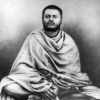Swami Vivekananda

Swami Vivekananda
Swami VivekanandaBengali: , Shāmi Bibekānondo; 12 January 1863 – 4 July 1902), born Narendranath Datta, was an Indian Hindu monk, a chief disciple of the 19th-century Indian mystic Ramakrishna. He was a key figure in the introduction of the Indian philosophies of Vedanta and Yoga to the Western world and is credited with raising interfaith awareness, bringing Hinduism to the status of a major world religion during the late 19th century. He was a major force in the revival of Hinduism in...
NationalityIndian
ProfessionClergyman
Date of Birth12 January 1863
CountryIndia
Modern Hinduism, modern Jainism, and Buddhism branched off at the same time. For some period, each seemed to have wanted to outdo the others in grotesqueness and humbuggism.
Present-day Hinduism and Buddhism were growths from the same branch. Buddhism degenerated, and Shankara lopped it off!
Hindus believe in God positively. Buddhism does not try to know whether He is or not.
Hindus believe Buddha to be an Avatara.
Too early religious advancement of the Hindus and that superfineness in everything which made them cling to higher alternatives, have reduced them to what they are. The Hindus have to learn a little bit of materialism from the West and teach them a little bit of spirituality.
All sectarian religions take for granted that all men are equal. This is not warranted by science. There is more difference between minds than between bodies. One fundamental doctrine of Hinduism is that all men are different, there being unity in variety. Even for a drunkard, there are some Mantras-even for a man going to a prostitute!
There is this difference between the love taught by Christianity and that taught by Hinduism: Christianity teaches us to love our neighbours as we should wish them to love us; Hinduism asks us to love them as ourselves, in fact to see ourselves in them.
The Hindus progressed in the subjective sciences.
That the Hindus, absorbed in the ideal, lacked in realistic observation is evident from this. Take painting and sculpture. What do you see in the Hindu paintings? All sorts of grotesque and unnatural figures. What do you see in a Hindu temple? A Chaturbhanga Narayana or some such thing. But take into consideration any Italian picture or Grecian statue-what a study of nature you find in them! A gentleman for twenty years sat burning a candle in his hand, in order to paint a lady carrying a candle in her hand.
In everything, there are two kinds of development-analytical and synthetical. In the former the Hindus excel other nations. In the latter they are nil.
Chemistry ceases to improve when one element is found from which all others are deductible. Physics ceases to progress when one force is found of which all others are manifestations. So religion ceases to progress when unity is reached, which is the case with Hinduism.
Hinduism threw away Buddhism after taking its sap. The attempt of all the Southern Acharyas was to effect a reconciliation between the two. Shankaracharya's teaching shows the influence of Buddhism. His disciples perverted his teaching and carried it to such an extreme point that some of the later reformers were right in calling the Acharya's followers "crypto-buddhists".
One point of difference between Hinduism and other religions is that in Hinduism we pass from truth to truth-from a lower truth to a higher truth-and never from error to truth.
The three essentials of Hinduism are belief in God, in the Vedas as revelation, in the doctrine of Karma and transmigration.